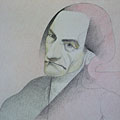Menú
Algunos dossiers
Juan Carlos
Distéfano
Distéfano
by
Adriana Lauria and Enrique Llambías
January 2003
January 2003
The dossier on Juan Carlos Distéfano spans from the time of his beginnings
as a painter to his recent works as a sculptor, a first for the CVAA. It covers
over forty years of his work and his commitment to art and reality. A special section offers a view on his work as a graphic designer, which he carried out mostly at the Di Tella Institute.
as a painter to his recent works as a sculptor, a first for the CVAA. It covers
over forty years of his work and his commitment to art and reality. A special section offers a view on his work as a graphic designer, which he carried out mostly at the Di Tella Institute.
Drawings
For Distéfano, only on rare occasions does a drawing not precede or stem from another work, such as a relief or a sculpture. There are few stand-alone cases and they only capture dear faces, such as the portrait of his wife in 1956 and that of Obdulio Gambaro, friend and brother in law, done in 1981. The rest of his innumerable drawings in graphite, ink, sanguine and silverpoint, to mention but a few of the techniques he employs, are a way of reflecting on the details of a sculpture through lines, graphs and shading: its structure, its look, its position and tension, its texture and almost its colour. His technique is impeccable. The classical appearance of his drawings makes them the most categorical proof of their relationship with sculpture, as they show volume, as well as the space generated and peopled by figures, with extraordinary forcefulness. Some of these works are the luminous survivors of an unsatisfactory project for a sculpture, like his 1979 version of The River at Sunset.



















